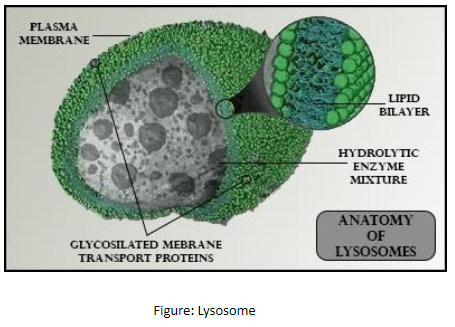
Why are lysosomes also known as scavengers of the cells?
(a)Lysosomes are capable of removing the cell debris having dead and turned cell organelle by digesting them.
(b)Lysosomes are not capable of removing the cell debris having dead and turned cell organelle by digesting them.
(c)Lysosomes are capable of removing the DNA, having died, and turned cell organelle by digesting them.
(d)None of the above
Answer
521k+ views
Hint: Lysosomes are single membrane-bound cellular organelles that possess many hydrolytic enzymes and this is the reason they are also called the suicide bags of the cell.
Complete answer:
Lysosomes also are known as scavengers of the cells because they are capable of removing the cell debris having dead and non-functioning cell organelle by digesting them. They are in the shape of spheres. The lysosomes have hydrolytic enzymes that can break down almost all kinds of biomolecules such as proteins, nucleic acids, carbohydrates, lipids, and cellular debris.

Additional Information:
-Lysosomes were discovered by the Belgian cytologist Christian René de Duve in the year 1955.
-By convention, the lysosome is the term used for animal cells.
-In the plant cells, the vacuoles do similar functions as the lysosomes.
-The lysosome is found nearly in all types of eukaryotic cells (cells with a clearly defined nucleus).
-Each lysosome is surrounded by a membrane that maintains an acidic environment within the interior via the proton pump.
-Lysosomes originate by budding off from the membrane of the trans-Golgi network, which is a region of the Golgi complex
So, the correct answer is, ’Lysosomes are capable of removing the cell debris having dead and turned cell organelle by digesting them.’
Note: The lysosomes break up larger molecules into smaller molecules. Those smaller molecules can then be used again as a building block for other large molecules. They contain more than 50 different enzymes.
Complete answer:
Lysosomes also are known as scavengers of the cells because they are capable of removing the cell debris having dead and non-functioning cell organelle by digesting them. They are in the shape of spheres. The lysosomes have hydrolytic enzymes that can break down almost all kinds of biomolecules such as proteins, nucleic acids, carbohydrates, lipids, and cellular debris.

Additional Information:
-Lysosomes were discovered by the Belgian cytologist Christian René de Duve in the year 1955.
-By convention, the lysosome is the term used for animal cells.
-In the plant cells, the vacuoles do similar functions as the lysosomes.
-The lysosome is found nearly in all types of eukaryotic cells (cells with a clearly defined nucleus).
-Each lysosome is surrounded by a membrane that maintains an acidic environment within the interior via the proton pump.
-Lysosomes originate by budding off from the membrane of the trans-Golgi network, which is a region of the Golgi complex
So, the correct answer is, ’Lysosomes are capable of removing the cell debris having dead and turned cell organelle by digesting them.’
Note: The lysosomes break up larger molecules into smaller molecules. Those smaller molecules can then be used again as a building block for other large molecules. They contain more than 50 different enzymes.
Recently Updated Pages
The number of solutions in x in 02pi for which sqrt class 12 maths CBSE

Write any two methods of preparation of phenol Give class 12 chemistry CBSE

Differentiate between action potential and resting class 12 biology CBSE

Two plane mirrors arranged at right angles to each class 12 physics CBSE

Which of the following molecules is are chiral A I class 12 chemistry CBSE

Name different types of neurons and give one function class 12 biology CBSE

Trending doubts
One Metric ton is equal to kg A 10000 B 1000 C 100 class 11 physics CBSE

What is 1s 2s 2p 3s 3p class 11 chemistry CBSE

Discuss the various forms of bacteria class 11 biology CBSE

State the laws of reflection of light

Explain zero factorial class 11 maths CBSE

An example of chemosynthetic bacteria is A E coli B class 11 biology CBSE




